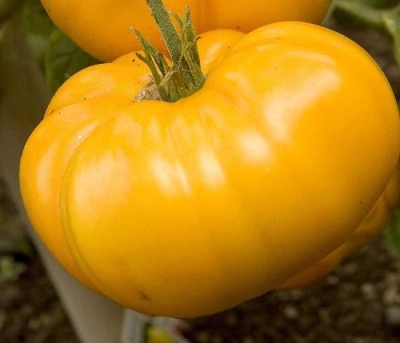
- Category: grade
- Growth type: determinant
- Appointment: fresh consumption, for pickling and preserving, for juice
- Ripening period: mid-early
- Growing conditions: for open ground, for film greenhouses
- Bush size: medium-sized
- Ripe fruit color: yellow
- Fruit shape: ribbed at the base
- Fruit weight, g: 200-250
- Pulp: aromatic, meaty, juicy, tender
Fig tomatoes are a whole varietal line that has appeared recently, but these beautiful and unusual vegetables have already become quite popular. This is not surprising, tomatoes are distinguished by excellent taste, fairly good yield, immunity to ailments, and most importantly - the original type of fruit. Today there are several varieties in this series - Figs are pink, red, yellow and even black. Let's talk about Yellow Fig, probably the most original of them.
Breeding history
A series of tomato varieties Fig breeders have bred relatively recently. Its originator is the well-known company "Gavrish" in the country. The yellow variety of the Fig varieties is the youngest, therefore it has not yet found such wide distribution. It is assumed that the crop can be grown both in the open field and in film greenhouses.
Description of the variety
The yellow fig belongs to the category of varieties, which means that it can be grown independently from seeds collected in your garden. The determinant shrub is usually medium-sized.
It is possible to distinguish both positive and negative properties of culture.
Advantages:
- high productivity;
- sweet berries;
- plucked fruits can ripen indoors, the taste does not change from this.
There are also disadvantages:
- intolerance to low temperatures;
- the need for formation.
The main qualities of the fruit
Of course, the most important difference between these tomatoes is their original appearance. Large fruits have an elongated top and ribbed sides. Moreover, the ribbing of the yellow fig is less pronounced than that of other representatives of the line. In general, tomatoes are very similar to the berries of a fig tree, which is where the name comes from. The mass of the yellow fig tomato variety varies from 200 to 250 g. The peel of the berries is thin, but strong, protecting the tomatoes from cracking. The pulp of Yellow Fig has the same color as the skin.
Taste characteristics
The taste of yellow figs is distinguished by high rates. The fruits are sugary, juicy, there is practically no acid. Tomatoes are fragrant, fleshy, tender, good for fresh consumption. They are also used for canning, juicing.
Ripening and fruiting
The culture is characterized by a mid-early ripening period.
Yield
Among the indicators of the yield of tomatoes, Fig yellow, a weight of 6-9 kg per square meter is mentioned.
The timing of planting seedlings and planting in the ground
The yellow fig variety is grown according to the traditional seedling technology. So, you can sow seeds for seedlings in late March or early April. Seedlings are planted in a permanent place at the beginning of May.

Growing tomato seedlings is an extremely important process, because it largely depends on whether the gardener will be able to harvest at all. All aspects must be taken into account, from seedbed preparation to planting in the ground.
Landing scheme
Plants should be planted according to a specific pattern - 40x60 cm.

Growing and care
As already mentioned, planting material can be obtained on your own, because Yellow Figs are not a hybrid. But many people prefer to purchase seeds in a specialty store.
Before planting, you need to prepare the seeds. For disinfection, the planting material is soaked in a weak solution of potassium permanganate for half an hour, after which they must be removed and dried. And also immediately before planting in the ground, the seeds are kept in any growth stimulator for an hour and a half. After drying, they are sown in prepared containers. The soil for planting seedlings can be either purchased in the store or prepared on your own.
Further, it is imperative to organize additional lighting with the help of special lamps, since the light will be needed for the sprouts for 14 hours during the day. Water the seedlings, depending on the state of the top layer, as it dries. You can not both fill and dry out the soil. It is also recommended to loosen the planting to ensure the supply of oxygen to the roots.
Care and cultivation of the Yellow Fig variety are quite traditional. It is necessary to carry out activities such as the garter and the formation of bushes. In this case, you need to leave only 1 stem for growing.




A plant needs different micronutrients at each stage of growth. All fertilizers can be divided into two groups: mineral and organic. Folk remedies are often used: iodine, yeast, bird droppings, eggshells.
It is important to observe the rate and period of feeding. This also applies to folk remedies and organic fertilizers.



























































































